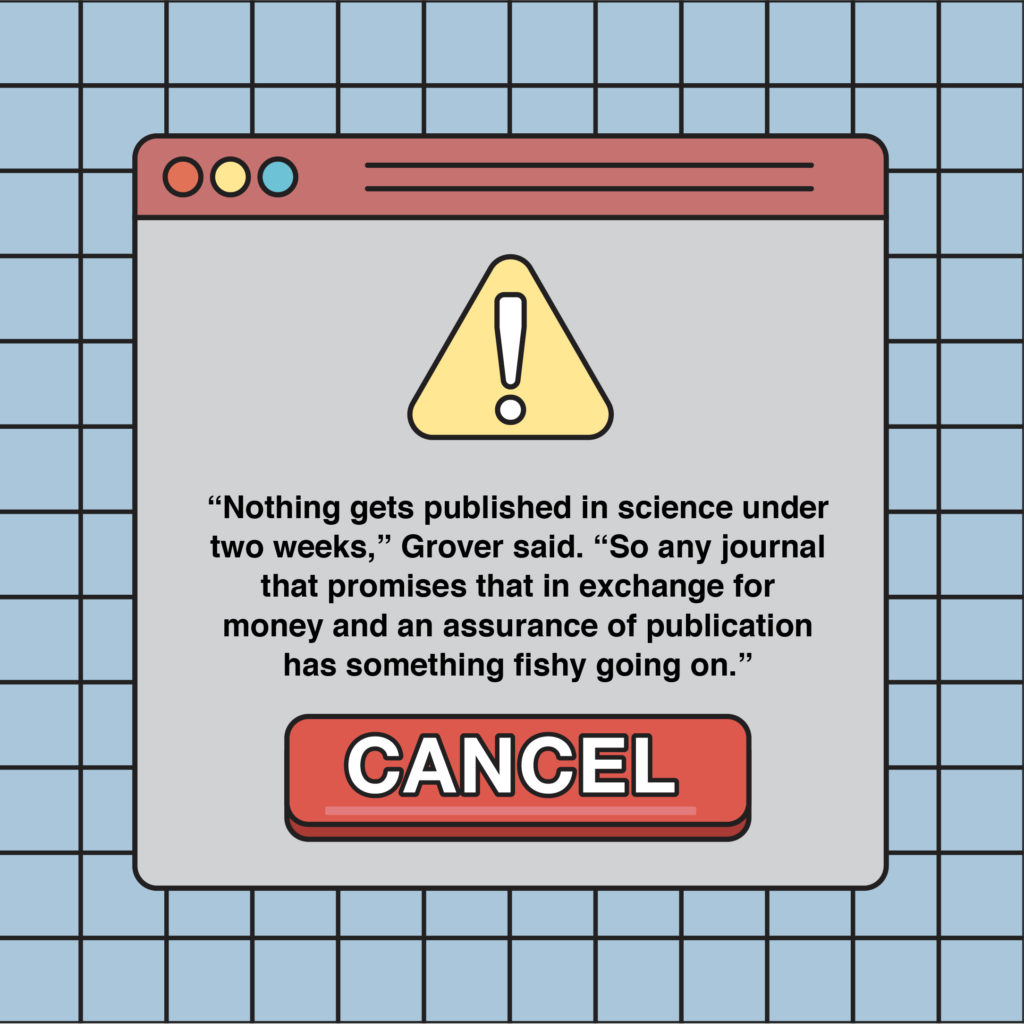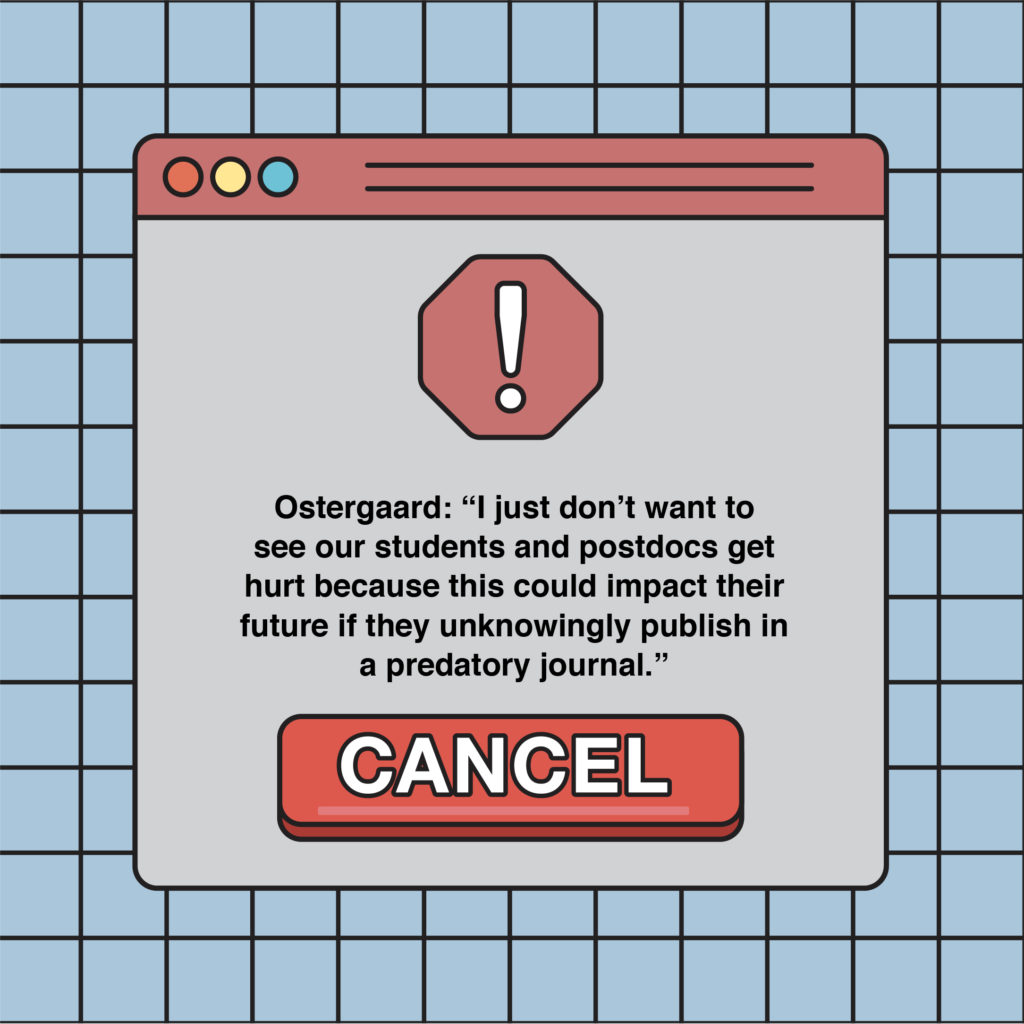For an up and coming scientist, getting their work published is an important first step, one that often takes years of work. But while there are plenty of reputable journals out there, not all of them are what they appear to be. Beneath a legitimate veneer lie predatory publishers, false scientific journals that try to take advantage of people’s work.
They guarantee publication of any work submitted, even if it’s gibberish. They also don’t provide the same editorial services reputable journals have, and often charge far cheaper publishing fees than their legitimate counterparts, making the barrier to entry quite low.
A predatory publication’s cheaper fees might seem like a deal to someone desperate to get published or looking to pad their CV. However, having one’s name associated with these phony journals hurts more than it helps. It can weaken reputations, cost valuable time and money, and damage the careers of seasoned professors and undergrad research assistants alike.
As William Grover, a bioengineering professor at the University of California Riverside, learned in late 2017, part of that shadiness includes making up entire academic institutions. When he took a closer look at one of the dozen emails he gets from predatory publishers, he found that an editor listed was a professor at California South University (CSU) — a university that does not actually exist.
“I’d never heard of it, despite apparently living just a few miles down the road from it,” Grover wrote in his blog.
When Grover found CSU’s website, he found that word for word of its history page was lifted from the University of Alberta’s Wikipedia entry, but with every mention of “Alberta” changed to “California.” They even claimed to have their own Butterdome, which Grover found quite funny. “You don’t hear a name like [the Butterdome] and forget about it easily.”
The website also lists a man named Alireza Heidari as one of their notable professors. After some further digging, Grover made an interesting discovery. As far as he could tell, Heidari — who likely isn’t real — is on the editorial board of over a hundred other journals.
“No legitimate professor is on a hundred editorial boards,” he said. “If you were that’s literally all you would do, that would be 110 per cent of your time right there.”
Grover’s theory is that the CSU website was created to give credibility to Heidari and to the journals he serves as an editor on. Many of the journals Heidari supposedly works for are produced by the OMICS Publishing Group, headquartered in Hyderabad, India. OMICS claims to publish over 700 journals and to have organized over 3,000 conferences around the globe.
Whereas other journals can take months to complete a peer review process, OMICS claims to take only 21 days to review a submission, followed by 15 days to post it online.
“Nothing gets published in science under two weeks,” Grover said. “So any journal that promises that in exchange for money and an assurance of publication has something fishy going on.”
OMICS Group’s practices — and its CEO, Srinubabu Gedela — have been criticized by many in the scientific community, and have been on the receiving end of a number of lawsuits. In 2016, the U.S. Federal Trade Commission (FTC) launched one against OMICS for misrepresenting scientists as editors on their journals and other deceptive practices like failing to disclose their publication fee until after the work was submitted. The FTC won its case in April 2019, and OMICS is required to pay $50 million USD in fines.
In addition to legal battles, journalists and academics have tested the rigour of the OMICS peer-review process by submitting pseudo-scientific work to their publications or conferences, often with humorous results.
In one such case, Tom Spears from the Ottawa Citizen submitted two papers to a biology conference organized by OMICS. The first paper was on the biomechanics of flying pigs. The second paper claimed that birds lived in the bottom of the ocean and that underwater robins are endangered by overfishing. Both papers were accepted and OMICS asked for a $999 publishing fee from Spears.

—
While OMICS is particularly notorious as a predatory publisher, that doesn’t stop people from submitting to journals or conferences organized by them.
Though the exact number changes frequently, OMICS’s website lists about 150 editors, contributors and speakers from the U of A — including the names of a few professors from disciplines like medicine and engineering. Also on the list are students who’ve done postdoctoral studies at the U of A and have since left. While many of these names appear to be genuine, it is unknown how they got onto a list of OMICS contributors, or if they even know their names are on there.
The problem of predatory publishing is known at the U of A, and research impact librarian Thane Chambers used to deliver workshops for researchers on how to spot a predatory publisher. She says finding a good publisher for your work is like finding a good apartment, as submitting good research to a questionable journal is a waste of one’s work.
“If you were renting an apartment, you would make sure it was built on a solid foundation… and actually had hot water,” Chambers said. “So it’s the same as finding a home for your article, you need to spend the time to investigate it a little bit.”
Chambers said for the fees predatory journals charge, getting published in them can seem like a deal: fees can range in the hundreds of dollars, whereas more reputable journals can charge thousands. But Chambers stressed that for those hundreds of dollars, the researcher isn’t getting the same kind of quality assurance they’d get from other journals.
“It’s giving them nothing,” she said. “They have a dodgy looking website, and there’s no peer review, there’s no copy editing, there’s nothing. It costs nothing, in terms of time or effort, to just post something on the web.”
Despite how contributing to publishers like OMICS is discouraged by academics, it still manages to happen, and not just to professors: students can become victims of these journals as well. A paper that Chambers is listed as a co-author was published in one of OMICS’s publications, the Journal of Nursing and Care.
As Chambers explained, the paper in question, “A Systematic Review on the Intersection of Homelessness and Healthcare in Canada,” was a student paper she’d helped with back in 2012. She doesn’t know exactly how that paper ended up in an OMICS journal as she wasn’t informed about the paper’s publication, but Chambers suspects that the lead author of the paper hadn’t examined the journal before submitting their work.
“I think it’s really important that, if you’re in a research group, there’s some discussion about where the paper is going to actually end up,” she said. “Because if somebody had told me about this journal, I would’ve easily looked it up and said no, we should consider something else.”
—
Poor communication within research groups and failing to evaluate journals before submitting work aren’t the only ways people accidentally end up affiliated with predatory journals. Some people partake in one of their conferences thinking they’re more legitimate than they really are. One such person was Korey Fung, a fourth-year dietetics student, who went to a pathology conference in New Orleans organized by OMICS International in 2015.
While taking a laboratory medicine and pathology course, Fung heard about the conference from his professor, who was approached by OMICS about presenting his work there. The professor was also encouraged to bring some of his students along. Seeing a chance to do something new, Fung signed up.
At the time, Fung thought the conference was legitimate enough and that there were people who were presenting on some serious work. But looking back on it now, there are a few details that seem peculiar to him. For one, Fung remembers one presentation had little to do with human pathology, and that the presenter’s background was in veterinary science.
“I just recall that there was a lady whose methodologies didn’t seem like they would be applicable to human pathology, and I was kind of curious as to why she was presenting in the first place,” Fung said.
Fung also recalled how some of the keynote speakers only stayed at the conference for an hour before flying out of New Orleans instead of staying to talk more about their research.
“The conference did feel like a way for some researchers to boost their CV,” he said.
—
While failing to be vigilant is one possible reason people publish in predatory journals, Chambers speculates that other reasons could exist, such as the pressure academics face to have a body of published work in order to put in a good performance review. It’s a sentiment that’s also known as “publish or perish” and for good reason: not having enough published work can hurt a professor’s chances of getting tenure, or even kill an academic career.

The idea that “publish or perish” is what’s pushing academics to publish in predatory journals is a common one. Grover is also convinced that researchers who are under that kind of stress are the real victims of predatory publishers.
“I think the victims in this are faculty members that are trying to get tenured and are under this ‘publish or perish’ kind of pressure,” Grover said. “And so when offered the opportunity to have an easy route to publication, it’s easy to fall into that trap. That’s the people these journals prey on, which is pretty despicable.”
However, Chambers said that raises more questions on a faculty level, like why the pressure to publish would be so strong, even if it means resorting to low-quality journals.
“I know the university would say ‘we would much rather you have two solid, good publication in good journals than 20,’ but for some reason, the researcher feels the need to have 20,” she said. “So something’s getting lost in translation there.”
—
According to Hanne Ostergaard, associate dean of graduate studies in the Faculty of Medicine and Dentistry, publication in predatory or low-quality journals is something that faculty evaluation committees keep an eye on. Ostergaard said the academic performance guide for the faculty mentions predatory publishing as something to avoid.
“Listed under unacceptable behaviour is being an editor of a predatory journal,” Ostergaard said in an email. “It further indicates that ‘it is the faculty member’s responsibility to determine the legitimacy of the journal with which they engage.’”
While participating in predatory journals is discouraged on a faculty level, Ostergaard stressed that it isn’t something for faculties to discipline or punish. Firstly, researchers have the academic freedom to publish wherever they want. Secondly, whether or not a journal is predatory isn’t necessarily agreed upon by everyone, as there are some legitimate open access journals that some might call predatory, and there are some journals that were legitimate but are no longer reputable.
“So it’s not a black and white issue, it’s very grey, so you can’t punish somebody for having published in what was a legitimate journal,” she said. “It’s a moving target. We tried to look at this for our faculty evaluation committee and it was just too complex.”
Ostergaard added that even though faculties can’t discipline people who publish in these journals, doing so can still hurt them in the long run and can affect their ability to receive research grant or get a faculty position, which is why it’s important to educate faculty members about them.
“I just don’t want to see our students and postdocs get hurt because this could impact their future if they unknowingly publish in a predatory journal,” she said.
Other universities in Canada are also faced with the problem of predatory publishing. When Eduardo Franco became the chair of the department of oncology at McGill University in 2011, he noticed while reviewing annual reports of faculty members that some of his professors were claiming membership in the editorial boards of these journals.
Franco also told his professors that they should resign from the editorial boards of those journals if they’re a part of them.
Like Ostergaard, Franco said that predatory journals are an “elusive target” due to the ambiguity of what is and isn’t a predatory journal. But it became a big enough issue for Franco to push it to the faculty level, putting a paragraph in all letter of appointments that professors should only submit work to reputable publishers.
“I have some 200 professors under my jurisdiction, and I sent a memo alerting them to the problem, urging them not to submit papers to these publishers,” he said.

—
Over a year after Grover wrote about CSU on his blog, the website for the non-existent California university is back up after being taken down, and Heidari is still listed as an editor on a number of OMICS journals which continues to push out publication after publication in his name.
Like how Heidari’s name and the non-existent university persists, so too will predatory journals which have taken root in the publishing landscape. While publishers like OMICS will continue to stick around for the foreseeable future, the best thing researchers can do is to be aware of them and to avoid submitting their work to those journals.
As for spotting a predatory publication, U of A Libraries have various resources on the subject. One of those resources is a checklist with steps like looking up if others have called a journal predatory, seeing how long the journal has been around, or checking if the publication is listed in the Directory of Open Access Journals (DOAJ). Chambers added that by following those steps, authors can save themselves the trouble later on.
“The university absolutely does not want anyone publishing in these journals because you’re [giving] away your research, really,” Chambers said. “You don’t want to have something on your CV that’s embarrassing.”




